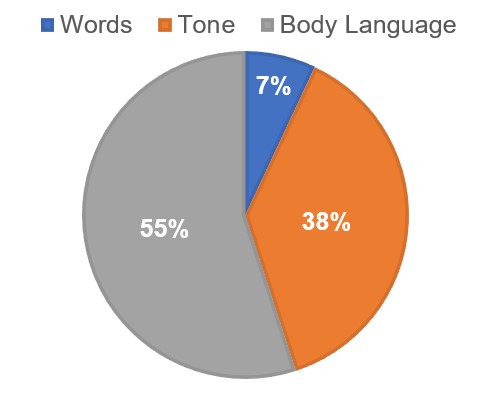If you’ve ever done some kind of communication training, you’ve probably heard some discourse on the relative importance of the content of what you say, how you say it (tone of voice) and what your appearance conveys (facial expression and body language). You may have seen this chart:

This is based on research by Professor Albert Mehrabian in the 1960s, but there is agreement that his research when presented in this basic fashion is widely misquoted and misunderstood.
If you think of famous speeches which have endured throughout history, how many of them were delivered behind a lectern or even via radio. Take Martin Luther King’s “I have a dream”, Winston Churchill’s “We’ll fight them on the beaches” or Emmeline Pankhurst’s “Freedom or Death”. None of these included much body language, yet they are some of the most memorable. This is a lot to do with the rhetorical devices they use, such as repetition, vivid imagery and metaphors, as well as incredibly strong and relevant messages.
Content matters, but it is an art form hard to achieve. People are only capable of remembering somewhere between 3 and 7 key messages. It takes a combination of clear message, clever content and powerful delivery to make something really stick. One of my favourite speeches is the one delivered by Charlie Chaplin in The Great Dictator (1940). The rhetorical devices used are incredible. The tone of voice crescendos. There is very little movement. It is a powerful message, eloquently crafted and delivered emotionally – this makes it memorable.
In the current world of lockdown where we can’t meet in person and everything is online, this becomes even more important. Video conferencing does not allow us to use body language in the same way – you might be able to see facial expressions and some gestures, but that’s not the same as connecting with someone in person in the same room. I’m not saying body language is not important. If you’re presenting in a situation where it is possible to use body language, then it will hugely add to the message. If there is a choice between presenting online with video on or off, I’d always advocate that you use the video, so your audience can see your facial expressions. The relative impact of content, voice and body language will vary depending on situation. The different preferences of the members of the audience will also mean that they are stimulated by different aspects of the content – some may prefer linguistic devices, some facts and figures, some more emotional connection.
The most important thing is congruence – your words, your voice, your facial expression all need to convey the same message.
Photo by Mihai Surdu on Unsplash
One thought to “Communication Congruence”
Pingback: Selling Yourself - Communication Clarity - Sarah Beckwith
Comments are closed.